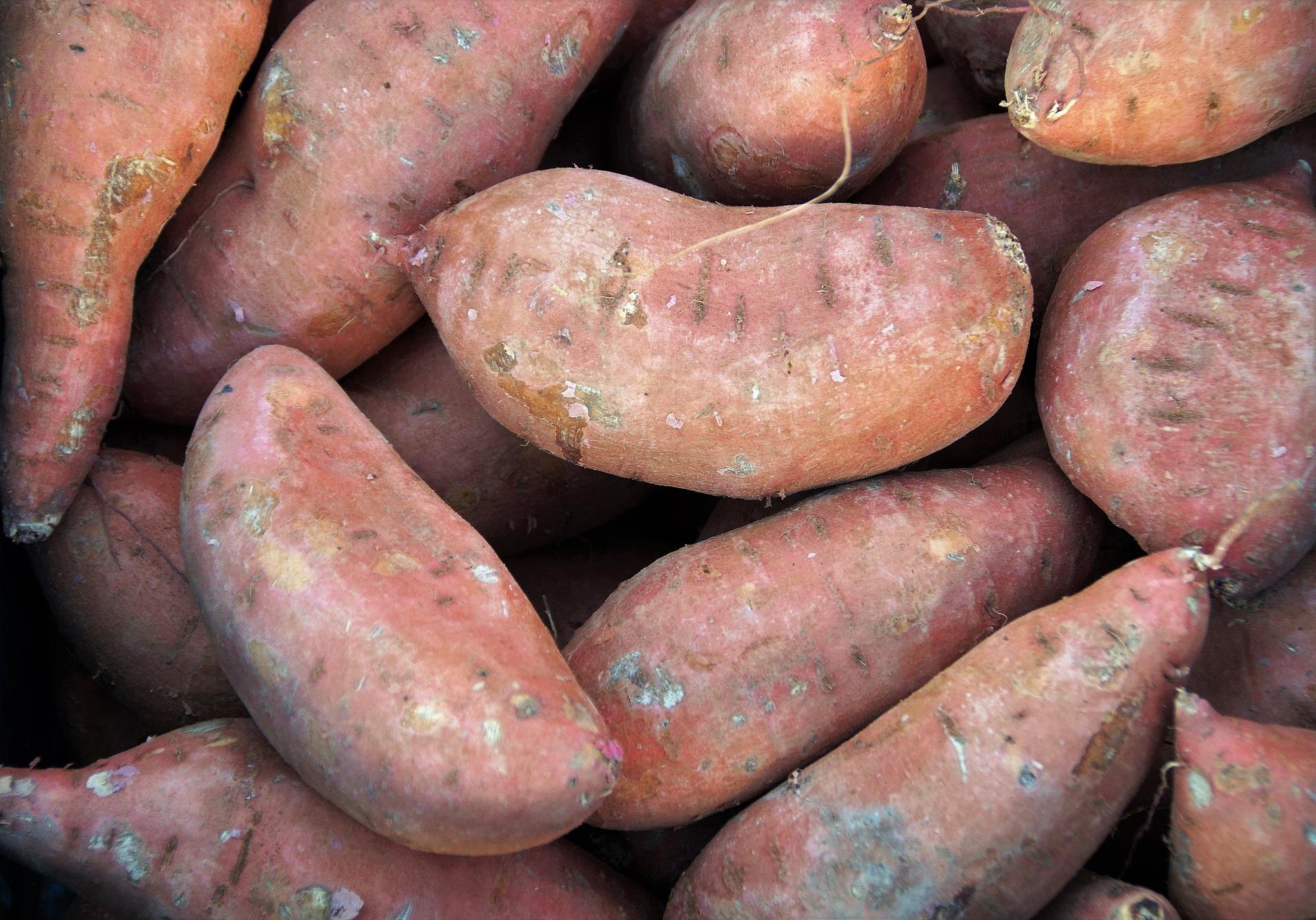Planting sweet potato facts
- Hardiness: Very tender warm-season annual. Frost will injure top growth; needs warm weather to grow.
- Planting: Plant sprouted new shoots (called "slips") after the soil has warmed to 65°F. Planting in ridges allows the soil to warm faster in the spring, improves drainage, and gives the roots room to expand. Ridging also makes harvesting easier. Sweet potatoes grow best in light, sandy soils but grow well on heavier soils, high in clay and amended with organic matter. Full sun requires direct light at least 6 hours/day; prefers 8 - 10 hours/day.
- Days to maturity: 85 - 120.
- Spacing: 12" in-rows x 40" between row.
- Fertilizer needs: Medium requirement for nutrients, either from soil organic matter or fertilizers. Incorporate compost prior to planting. On light, sandy soils side-dress with a nitrogen source once or twice during the growing season. Refer to Fertilizing Vegetables for details.
- Approximate yield: 15-30 lbs. per 10-foot row.
Common sweet potato problems
Growing and care of sweet potatoes
- The sweet potato (Ipomoea batatas) belongs to the family Convolvulaceae. The large, starchy, sweet-tasting roots are an important vegetable crop worldwide. Young leaves and shoots can be eaten as greens. The sweet potato probably originated in the tropical parts of South America and was domesticated there at least 5000 years ago. It will tolerate relatively dry weather.
- Cultivars with moist flesh (Georgia Jet, Centennial, Vardaman) predominate in the United States. They are derived from the cultivar 'Porto Rico', and are sometimes called yams. Japanese and Korean sweet potatoes are drier, store better, and are becoming more popular in Maryland. The true yam (Dioscorea spp.) is grown primarily in tropical and semitropical areas for its tubers.
- Sweet potato slips are often difficult to find (there are online sources). You can also grow your own.
- Sweet potatoes are storage roots, not tubers. New shoots will emerge along the entire root. The process from bedding to planting takes six weeks.
Here are some tips for growing your own:- Buy certified seed stock at a garden center or your favorite varieties from a market. Wash the latter to remove anti-sprouting chemicals.
- Cover the bottom of a flat or container with 1 to 2 inches of coarse sand or soilless growing mix.
- Slice the roots lengthwise and place them cut-side-down in the container. Cover with 2 inches of coarse sand or growing mix.
- Keep your roots moist, warm (75°- 85°F), and covered with plastic until plants emerge.
- Remove plastic. Grow plants directly under cool, white fluorescent tubes for 14 - 16 hours per day.
- Pull slips from bedded roots and plant after the danger of frost. Slips are rootless when pulled from the mother root; keep them well-watered. You can also take cuttings from the slips and pot them up into containers.
- Watering – Keep plants uniformly supplied with moisture for best performance. Sweet potato is sensitive to drought for the first 50 to 60 days after planting. Water deeply and regularly during dry periods. But excessive water can cause root rots and storage roots to split.
- Weeding – Remove weed seedlings by hand or with a hoe until the plant begins to grow. The rapidly growing vines will shade out weeds, so little additional weeding is needed. An organic mulch is beneficial where weed pressure is high.
Harvesting sweet potatoes
- The foliage is edible and very nutritious. Eat it fresh in a green salad or sauté with other vegetables.
- Harvest roots as soon as they reach eating size and before a frost.
- Sweet potatoes generally mature in 85 to 120 days. Check root size after 80 to 85 days because they don't stop growing and can start to split when overgrown.
- Digging is easier if you cut the vines off first.
- Use a garden fork or spade to loosen the soil and gently lift up and expose the sweet potatoes. Handle them with care, gently removing attached soil clumps. Don't rub the skin or wash roots prior to storing indoors.
- If the vines are exposed to frost, dig the roots immediately because decay in dead vines passes down to the roots. If immediate digging isn’t possible, cut away vines and throw loose soil over the rows to protect the sweet potatoes from the cold. Soil temperatures below 50 degrees F. can cause chilling injury.
Curing, storage, and preservation of sweet potatoes
- Commercial growers cure their sweet potatoes in special rooms at 85 degrees F. and 80% to 90% relative humidity (RH) for 5 to 10 days. Curing causes the conversion of starch to sugar and helps to heal cuts that could lead to rots. The roots are then stored for 6-8 weeks at 55 to 60 degrees F. to further increase the sugar content.
- Duplicating this process would be very difficult for home gardeners! You can at least partially cure the roots by leaving them on a porch or other covered outdoor location (or in a garage) for a week or so. This works best if you harvest in September when temperature and humidity are still relatively high.
- Spreading the roots out on a screen in a single layer is best.
- If curing outdoors, be sure to protect them from rain and animals.
- Then move the roots to a cool, dry basement, if possible, and store them through the winter in boxes, bins, or baskets, lined with newspaper that allow for good air movement. The sugar content will slowly increase in storage. Roots store best at 55° to 60°F at 85% - 90% RH.
- The roots will shrivel and sprout if temperatures are too high. The roots will usually store successfully even if the one-week curing process is omitted.
